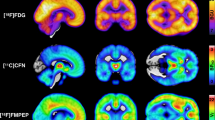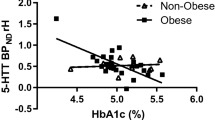Abstract
Objective:
Vascular endothelial growth factor (VEGF) has been suggested to enhance glucose transport across the blood–brain barrier, thereby increasing brain glucose supply. Increased brain glucose concentration is known to suppress food intake and to decrease body mass via action on hypothalamic regulation centers. Based on the crucial role of VEGF on brain glucose supply, we hypothesized that higher VEGF concentrations are associated with lower food intake and body mass in humans.
Methods:
Intending to investigate subjects with high variance of blood glucose, we examined patients with type 2 diabetes mellitus. Our hypothesis was tested in a population-based cohort of 190 subjects with type 2 diabetes. Plasma VEGF levels in conjunction with other parameters known to modulate food intake were measured and subsequently correlated with food intake patterns at a breakfast buffet as well as with body mass.
Results:
We found that subjects with higher concentrations of plasma VEGF had 17% less carbohydrate intake (P=0.003) and 4.8% lower body mass (P=0.017) than those with lower VEGF concentrations. Intake of protein and fat did not correlate with VEGF concentrations. These associations of plasma VEGF were confirmed in multiple linear regression analyses controlling for several parameters interacting with food intake.
Conclusion:
We conclude that high plasma VEGF concentrations are associated with less carbohydrate intake and lower body mass in type 2 diabetes. The role VEGF plays in facilitating glucose access to the brain represents a new aspect of food intake regulation and energy homeostasis, with relevance for diseases with body mass disturbances.
This is a preview of subscription content, access via your institution
Access options
Subscribe to this journal
Receive 12 print issues and online access
$259.00 per year
only $21.58 per issue
Buy this article
- Purchase on Springer Link
- Instant access to full article PDF
Prices may be subject to local taxes which are calculated during checkout

Similar content being viewed by others
References
Mokdad AH, Ford ES, Bowman BA, Dietz WH, Vinicor F, Bales VS et al. Prevalence of obesity, diabetes, and obesity-related health risk factors, 2001. JAMA 2003; 289: 76–79.
Peters A, Schweiger U, Fruhwald-Schultes B, Born J, Fehm HL . The Neuroendocrine Control of Glucose Allocation. Exp Clin Endocrinol Diabetes 2002; 110: 199–211.
Peters A, Schweiger U, Pellerin L, Hubold C, Oltmanns KM, Conrad M et al. The Selfish Brain: Competition for Energy Resources. Neurosci Biobehav Rev 2004; 28: 143–180.
Davis JD, Wirtshafter D, Asin KE, Brief D . Sustained Intracerebroventricular Infusion of Brain Fuels Reduces Body Weight and Food Intake in Rats. Science 3-4-1981; 212: 81–83.
Oomura Y, Ooyama H, Sugimori M, Nakamura T, Yamada Y . Glucose Inhibition of the Glucose-Sensitive Neurone in the Rat Lateral Hypothalamus. Nature 1-2-1974; 247: 284–286.
Pardridge WM, Boado RJ, Farrell CR . Brain-Type Glucose Transporter (GLUT-1) Is Selectively Localized to the Blood-Brain Barrier. Studies With Quantitative Western Blotting and in Situ Hybridization. J Biol Chem 1990; 265: 18035–18040.
Mani N, Khaibullina A, Krum JM, Rosenstein JM . Activation of Receptor-Mediated Angiogenesis and Signaling Pathways After VEGF Administration in Fetal Rat CNS Explants. J Cereb Blood Flow Metab 2003; 23: 1420–1429.
Sone H, Deo BK, Kumagai AK . Enhancement of Glucose Transport by Vascular Endothelial Growth Factor in Retinal Endothelial Cells. Invest Ophthalmol Vis Sci 2000; 41: 1876–1884.
Cines DB, Pollak ES, Buck CA, Loscalzo J, Zimmerman GA, McEver RP et al. Endothelial Cells in Physiology and in the Pathophysiology of Vascular Disorders. Blood 15-5-1998; 91: 3527–3561.
Ferrara N . Vascular Endothelial Growth Factor: Basic Science and Clinical Progress. Endocr Rev 2004; 25: 581–611.
Pekala P, Marlow M, Heuvelman D, Connolly D . Regulation of Hexose Transport in Aortic Endothelial Cells by Vascular Permeability Factor and Tumor Necrosis Factor-Alpha, but Not by Insulin. J Biol Chem 25-10-1990; 265: 18051–18054.
Wang W, Merrill MJ, Borchardt RT . Vascular Endothelial Growth Factor Affects Permeability of Brain Microvessel Endothelial Cells in Vitro. Am J Physiol 1996; 271 (6 Pt 1): C1973–C1980.
Dantz D, Bewersdorf J, Fruehwald-Schultes B, Kern W, Jelkmann W, Born J et al. Vascular Endothelial Growth Factor: a Novel Endocrine Defensive Response to Hypoglycemia. J Clin Endocrinol Metab 2002; 87: 835–840.
Gavin JR, Alberti KGMM, Davidson MB, DeFronzo RA, Drash A, Gabbe SG et al. Report of the Expert Committee on the Diagnosis and Classification of Diabetes Mellitus. Diabetes Care 2003; 26 (Suppl 1): S5–S20.
Pudel V, Westenhoefer J . Fragebogen zum Eßverhalten: Handanweisung. Goettingen: Hogrefe, 1989.
Karschin C, Ecke C, Ashcroft FM, Karschin A . Overlapping Distribution of K(ATP) Channel-Forming Kir6.2 Subunit and the Sulfonylurea Receptor SUR1 in Rodent Brain. FEBS Lett 1997; 401: 59–64.
Levin BE, Dunn-Meynell AA, Routh VH . Brain Glucose Sensing and Body Energy Homeostasis: Role in Obesity and Diabetes. Am J Physiol 1999; 276 (5 Pt 2): R1223–R1231.
Sergeyev V, Broberger C, Gorbatyuk O, Hokfelt T . Effect of 2-Mercaptoacetate and 2-Deoxy-D-Glucose Administration on the Expression of NPY, AGRP, POMC, MCH and Hypocretin/Orexin in the Rat Hypothalamus. Neuroreport 17-1-2000; 11: 117–121.
Miselis RR, Epstein AN . Feeding Induced by Intracerebroventricular 2-Deoxy-D-Glucose in the Rat. Am J Physiol 1975; 229: 1438–1447.
Thompson DA, Campbell RG . Hunger in humans induced by 2-Deoxy-D-Glucose: glucoprivic control of taste preference and food intake. Science 1977; 198: 1065–1068.
Proescholdt MA, Jacobson S, Tresser N, Oldfield EH, Merrill MJ . Vascular endothelial growth factor is expressed in multiple sclerosis plaques and can induce inflammatory lesions in experimental allergic encephalomyelitis rats. J Neuropathol Exp Neurol 2002; 61: 914–925.
Schwartz MW, Woods SC, Porte Jr D, Seeley RJ, Baskin DG . Central nervous system control of food intake. Nature 2000; 404: 661–671.
Gielkens HA, Verkijk M, Lam WF, Lamers CB, Masclee AA . Effects of hyperglycemia and hyperinsulinemia on satiety in humans. Metabolism 1998; 47: 321–324.
Mayer J, Thomas DW . Regulation of food intake and obesity. Science 1967; 156: 328–337.
Gold PW, Chrousos GP . Organization of the stress system and its dysregulation in melancholic and atypical depression: High Vs Low CRH/NE States. Mol Psychiatry 2002; 7: 254–275.
Arase K, York DA, Shimizu H, Shargill N, Bray GA . Effects of corticotropin-releasing factor on food intake and brown adipose tissue thermogenesis in rats. Am J Physiol 1988; 255 (3 Pt 1): E255–E259.
Hamilton CL, Lewis D . Feeding behavior in monkeys with spontaneous diabetes mellitus. J Med Primatol 1975; 4: 145–153.
Ferrara N, Henzel WJ . Pituitary follicular cells secrete a novel heparin-binding growth factor specific for vascular endothelial cells. Biochem Biophys Res Commun 1989; 161: 851–858.
Gaillard I, Keramidas M, Liakos P, Vilgrain I, Feige JJ, Vittet D . ACTH-regulated expression of vascular endothelial growth factor in the adult bovine adrenal cortex: a possible role in the maintenance of the microvasculature. J Cell Physiol 2000; 185: 226–234.
Jakeman LB, Winer J, Bennett GL, Altar CA, Ferrara N . Binding sites for vascular endothelial growth factor are localized on endothelial cells in adult rat tissues. J Clin Invest 1992; 89: 244–253.
Leybaert L . Neurobarrier coupling in the brain: a partner of neurovascular and neurometabolic coupling? J Cereb Blood Flow Metab 2005; 25: 2–16.
Aiello LP, Pierce EA, Foley ED, Takagi H, Chen H, Riddle L et al. Suppression of retinal neovascularization in vivo by inhibition of vascular endothelial growth factor (VEGF) using soluble VEGF-receptor chimeric proteins. Proc Natl Acad Sci USA 1995; 92: 10457–10461.
De Vriese AS, Tilton RG, Elger M, Stephan CC, Kriz W, Lameire NH . Antibodies against vascular endothelial growth factor improve early renal dysfunction in experimental diabetes. J Am Soc Nephrol 2001; 12: 993–1000.
Rivard A, Silver M, Chen D, Kearney M, Magner M, Annex B et al. Rescue of diabetes-related impairment of angiogenesis by intramuscular gene therapy with Adeno-VEGF. Am J Pathol 1999; 154: 355–363.
Schratzberger P, Walter DH, Rittig K, Bahlmann FH, Pola R, Curry C et al. Reversal of experimental diabetic neuropathy by VEGF gene transfer. J Clin Invest 2001; 107: 1083–1092.
Acknowledgements
We thank Dr Aja Marxsen, Oliver Korn, Stefan Sopke and Christina Blum for their expert assistance and invaluable work.
Author information
Authors and Affiliations
Corresponding author
Rights and permissions
About this article
Cite this article
Hubold, C., Oltmanns, K., Schultes, B. et al. High plasma VEGF relates to low carbohydrate intake in patients with type 2 diabetes. Int J Obes 30, 1356–1361 (2006). https://doi.org/10.1038/sj.ijo.0803293
Received:
Revised:
Accepted:
Published:
Issue Date:
DOI: https://doi.org/10.1038/sj.ijo.0803293



